Derf has been a notable graphic artist for decades, and his strip “The City,” launched in 1990, appears in alternative papers and online weekly. His other works include the autobiographical one-shot “Trashed” and the 2010 graphic novel “Punk Rock and Trailer Parks,” a fictionalized account of the punk rock scene of Akron, Ohio in 1980. But it’s the tale of his childhood friendship with Jeffrey Dahmer that’s caused him to receive more critical acclaim in recent times.
Published last year, Derf’s “My Friend Dahmer” has been hugely successful both critically and financially, entering its fourth printing and nominated for both Reuben, Ignatz and Eisner awards for Best Graphic Novel, and named by Time Magazine as one of the ten best non-fiction books of the year. It’s a well-deserved reaction for the book, which chronicles the high school days of Jeffrey Dahmer through the memory of Derf, with whom he was friends at Revere High School in Bath Township, Ohio.
“My Friend Dahmer” had been a long time coming from Derf, first emerging in a smaller form as a one-shot comic self-published in 2002. Not the standard serial killer fare, Derf’s graphic novel eschews any chronicling of Dahmer’s later victims (the book ends as he claims his first) and instead takes a look at what caused him to turn into the monster the world now thinks of when they hear his name. I had a chance to talk to Derf at Chicago’s C2E2 convention, where he hosted a panel about the book.
P: Do you do a lot of conventions like this?
D: No, I don’t. The mainstreams? No, I don’t do a lot. I was at the New York Comic Con and that took me months to recover from. Too many people, too creepy, too corporate. I do the indie shows. I really like those. Those are a lot of fun – I’m going to TCAF, and I’ll be here for CAKE. Those are great. You just feel really cool after those. After one of these, you just need to take a shower.
P: It’s been kind of a long promotional tour for you, because the book came out almost a year ago.
D: Well, people keep wanting to hear about it. So I’m happy to talk about it and sell books, that’s great. And now the foreign editions are coming out.
P: You mentioned in the panel that they had no idea as to who Jeffrey Dahmer was in France.
D: No, none. But I got huge media there – every major paper, and they’re all national papers, radio, and I don’t really like doing TV, so I didn’t do any TV – but it’s amazing. They’re just fascinated by the story. They found out about Dahmer for the first time and then there’s this whole graphic novel. It’s great, it was a lot of fun.
P: Do you think they’re fascinated by Jeffrey Dahmer as a character or the story itself?
D: I think it’s the story itself. They find out what he did, and then they want to read the story. It’s the story itself that’s really great, because in the U.S., all they want to talk about is Dahmer. Not about how I did it, they’re just interested in Dahmer. I get it, and I knew that was going to be part of it, but over there it was completely different. It was very refreshing.

P: Was that one of the issues that you had with getting the full graphic novel version of the story greenlit?
D: It was weird, you know. I don’t understand it. A lot of these companies will put out, you know, Sex Crazed Zombies from Hell without a moment’s hesitation, but this story they didn’t want to touch because it creeped them out? C’mon. I didn’t understand it then, I guess they had felt it was going to be about… I guess necrophilia is the cutting-off point there? Everything else would have been acceptable, but having sex with dead bodies, no, we can’t do that. And I get that, but that’s not what the story’s about.
P: If it was more of a straightforward serial killer story, do you think it would have been thought of as more accessible?
D: Maybe, I don’t know. I never thought of the story that way, and I was not interested in doing that story, so I have nothing to base that on. Maybe if it wasn’t real, maybe they would have jumped at it if was just fantasy. But obviously not, you walk around the main floor [of the convention] and you see so many zombie books, and serial killer books, and all that shit. But I never really pressed them about what freaked them out about it. I just got the “no” and that was enough, I just wrote them off. So who knows?
I like that when people start in on the book, maybe not as much now because of the rep of the book, but at first when they just got in, they were expecting one kind of story and by the time they got to the very end, they realized they’d read something very different. And I kind of got off on that manipulation. And that’s what I wanted them to do. It had an effect on some readers, when they get to the end, it’s completely different.
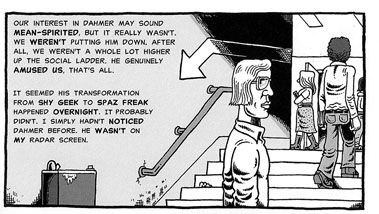
P: That’s what I really like about the book – it’s not a story about a serial killer. It’s a period piece about this world that he came from.
D: Well, it’s a story about not fitting in, it’s a story about dysfunction, it’s got a lot of things going on. We all know a potential Jeffrey Dahmer. They’re out there. And some of them get stopped or get better, and others not. But what we’re seeing now, God, like every month? Some guy who flips out and we’re left with a pile of bodies. So if there’s a lesson there, it’s certainly not one we’re willing to learn.
P: It gets very much into the discussion of mental health care, and knowing what to do when you see something.
D: Warning signs, yeah. It’s too easy just to keep kicking these kids down the road. In Dahmer’s case, I still can’t believe, even though I never found anybody who’d own up to it, that none of the adults used to notice that he was drunk. I mean, he used to walk through the halls of school with a coffee cup out of the vending machine, full of whiskey. Just walk down the middle of a crowded hall! And part of why he got away with that mask he had, where you couldn’t read him.
Think of any stoner you know, he’s trying to pull the same thing off on a bet, he’d be sweating bullets! The assistant principal would have him spotted from a mile away! Dahmer was just this mask. And he was just so brazen and so unexpected. Who would do that? But he would. And I’ve got pictures of him, holding that coffee cup. And I can’t believe any teacher didn’t notice the bizarre behavior, the breath… they didn’t care. It’s just like, “Well, you know, he’s a senior. In a couple months, he’ll be somebody else’s problem. “ Well, he was somebody else’s problem. The result was tragic.
P: I know it’s very different in tone, but “Punk Rock and Trailer Parks” is very similar in the sense that you’re kind of viewing the lives of these major figures through the filter of your own experiences. Did that kind of inform how you went about putting together “My Friend Dahmer?
D: Well, they’re very different books. “Punk Rock and Trailer Parks” of course is fiction – I’m amazed at how many people think it’s not. I hear that all the time, “Oh, I was at that show, I always wondered what happened!” And it’s like, no, man, I just made that all up. You weren’t at that show. But certainly the storytelling is very similar, and some of the small town dynamics. You write what you know, and you pull things from your own life even if you’re doing fiction. And then you fictionalize them, and plug them into the same vibe, and if gives it kind of a real-life feel, I think. I find that to be a very useful technique. Whether I can translate that into other work, like sci-fi or something, I have no idea. I’d be interested to see if I can. Certainly there’s some similarities, there’s a similar place, it’s sort of a similar time in that “Punk Rock” takes place a little after. The tone is very different.
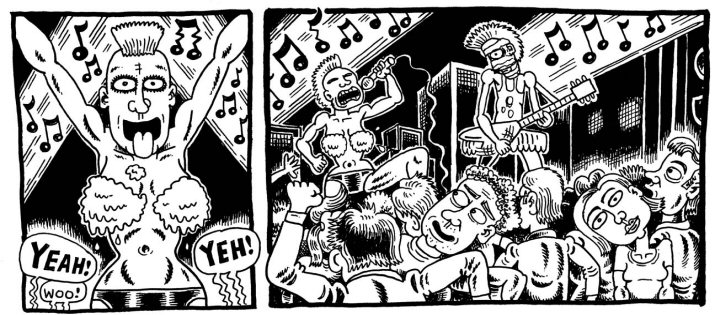
P: You’d also done “Trashed,” which is also very autobiographical.
D: “Trashed” is, yeah. It’s pure non-fiction – well, I just had a bizarre e-mail from a librarian saying that graphic novels can’t be non-fiction because you’re recreating something. I get that, I don’t know if I agree with it. So it’s non-fiction fiction? I don’t know, whatever you call it.
P: Well, it’s all depending on how much you’re fictionalizing these stories.
D: Yeah. Eventually, I’m going to put together a big “Trashed” book, I think. I’ve gone back to it over the years and done a couple webcomics, and there’s been some interest in that. So that’ll be fun. Maybe it’ll be a scratch and sniff book.
P: I re-read “Trashed” recently, and thought it would make for a great short film.
D: Oh, yeah. Well, maybe it’ll be a long film. And I’ll probably work in a little more of that stuff. The people in that are a little older – I’m done writing about high school. But it’s that same kind of finding your way type story, and again, it’s a story that nobody knows about, what it’s like to be a garbage man. There’s this whole secret world that we don’t think about. We put the trash out, and a few hours later, it’s just gone. It’s a miracle! But there’s this whole world that’s developed around this. I think it’s fascinating.
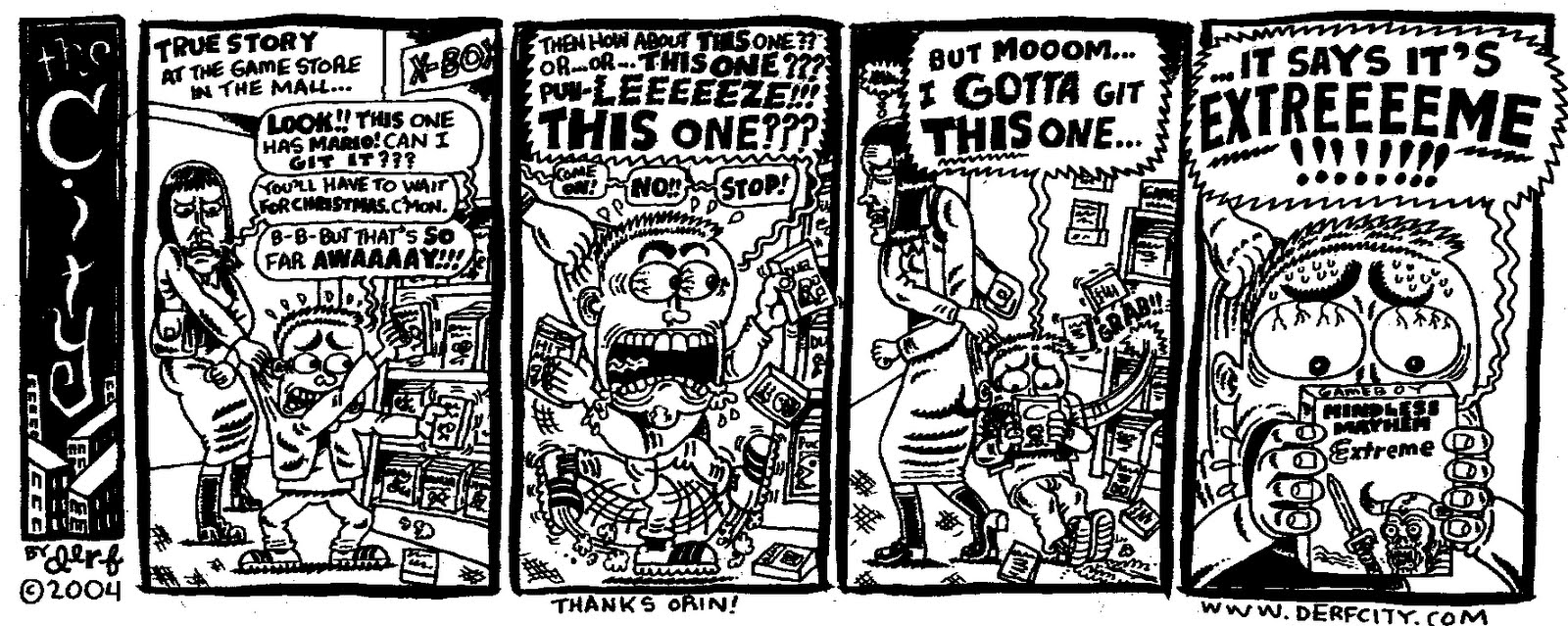
P: Was it different switching from the four-panel layout of “The City” to doing a longer-form piece?
D: The layout was very hard. I didn’t think it would be, but it was. One of the biggest problems was learning to slow down. With four panels, you’ve got to get in, you’ve got to make your point, and you’ve got to get out. And with a graphic novel, depending on the pacing — “My Friend Dahmer” has this very slow, methodical pacing – that I really had to struggle to do. You kind of see that with “Trashed,” it’s a little bit too fast. “Punk Rock and Trailer Parks” is a little bit slower, but it’s still a little fast. It was really a process of learning how to slow down.
Now you don’t want to get to the point where you have what [“Love and Rockets” co-creator] Jaime Hernandez calls “the fluttering leaf syndrome,” which is like a staple of indie comics where you have like two pages where a leaf is floating through the scene. You don’t want to get to that extreme, so you’ve got to find your pace.
“Punk Rock and Trailer Parks” is a lot denser than this. It was like nine panels to a page. The base line for “My Friend Dahmer” is four panels to a page, and that was kind of by design as well. I really wanted to be able to get into the drawing. But now I’ve found I’ve had a lot of trouble going back to doing the strip. It’s really a struggle to pace myself because you’re used to this open-ended story. I have to say I really enjoy it. So I’ll probably stop doing comic strips. What’s the point? Obviously, I’ve had a lot more success at this than I ever had with the comic strip, so it’s my natural genre. Why fight it? Not that I didn’t love doing a comic strip.
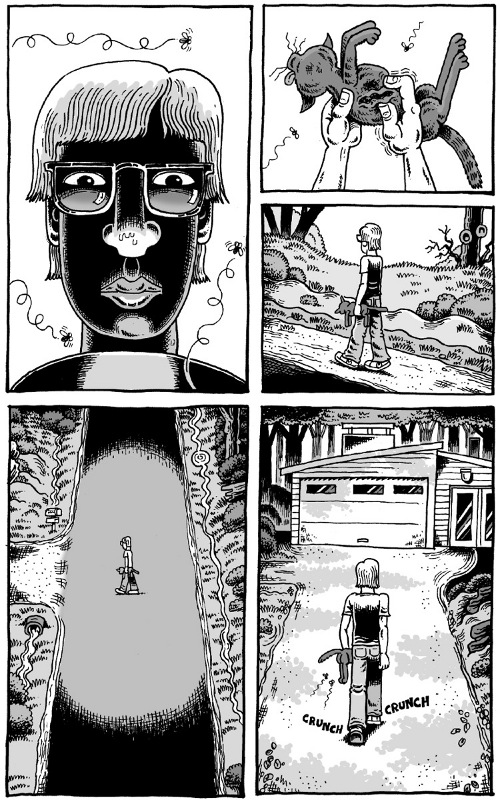
P: I was looking at the Plain Dealer [the Ohio newspaper in which The City runs online] and they’ve got the open comments that are pretty entertaining.
D: Yeah, that’s something! The trolls. Newspaper comments sections are always like that. You get all these people who hate the paper that feel compelled to comment on everything that’s in the paper that they hate. It’s really just this weird kind of world of bitching and cheap shots.
P: There are kind of two very distinct voices in “Dahmer,” where it’s this voice from high school done through the dialogue, and the more narrative voice, which is more retrospective – was that difficult to juggle, looking back at what you wrote at the time and then addressing that?
D: It took some effort, yeah. You had to keep the voices separate. Once I got into it, it was easier than it sounds, and I did have my old papers to go by, and I didn’t want to make myself, at 17, sound too intelligent or aware, because I was anything but. So I always had to dumbass myself down. Because I did have those papers, though, I was able to do it.
P: Was there an intention to tone down a little of the cartoonishness of the strip for “Dahmer?”
D: Very much so. I don’t think I did that with “Trashed” – “Trashed” is very much how I used to draw at the time. But with “Punk Rock and Trailer Parks” I started to really change. And with “My Friend Dahmer” – some people still say it’s too cartoony. You know how comics fans are, they’re really weird. If it’s not like pure realism or the manga-inspired, big-booby mainstream stuff, they tend to compartmentalize you. But I was trying to draw much more realistically without losing my root style, and that took a lot of work. It was a long process. I like the way I’m drawing, and I liked the way I was drawing before. Moving forward, hopefully I’ll get a little better – we’ll see.
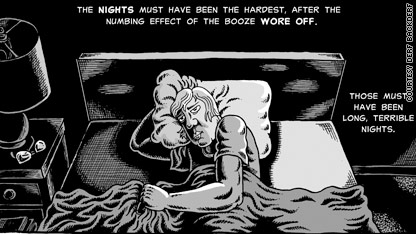
P: I do think it lends itself to “My Friend Dahmer” considering the period of the book, and if you had art that was completely heavy and dark, it would become brooding.
D: Yeah. I pile on night scenes at the end of the book. That was really by design, and maybe it’s melodramatic, but it was kind of mirroring what was happening in Dahmer’s life. Just getting darker and darker and more and more claustrophobic. So that was by design. I kind of like the way that turned out. Now moving forward, if I do something set in modern times, will it translate? Well, I hope so. You draw like you draw, I’m not going to change.
P: You’ve said that you’re not really a serial killer fan – would you be interested in where Dahmer came from had you not known him personally?
D: No. Probably not. I wouldn’t have done this story if I hadn’t been a part of it. This was just something that dropped from the sky and fell in my lap. All my other work is this raucous humor. And I knew going into this – maybe this was one of the reasons I put it off as long as I did – that this was going to be my best-known work. I never doubted it, because it’s such a unique story. I’ll likely never do anything like it again, but I didn’t want it to define me right from the beginning, so I went out and did other books first, and even though this is my best-known work, at least I already have a body of work, so maybe I can escape that. The way I look at it, it’s better to have a best-known work than to not have one, so I’ll just deal with it and move forward. Hopefully with more readers.
P: Are you going to be associated with the film adaptation at all? Or is that still in the conceptual stages?
D: Still in the conceptual stages. I haven’t seen the screenplay yet. The filmmaker actually came to Ohio and spent a couple days with me, and we actually walked through the book scene by scene. It was a really interesting process I’d never done before in order. Here’s where Dahmer did this, here’s where he did that… We went into the school after hours and just walked in – they could have arrested us if they’d wanted to, but they didn’t. The pressure’s on him — we joked about it. He’s a really good filmmaker – he won some indie awards, some film festival stuff. So it’s not mainstream sleazy. And like I told him, I did the work I wanted to do. You have to live up to the book, not the other way around. You blow it, they’re going to say, it’s not anyway near as good as the book. [laughs] It’ll be like THE LEAGUE OF EXTRAORDINARY GENTLEMEN. So the pressure’s on [him]! But it’s a weird process handing off something so personal to somebody else to make into another work of art. I’ve never done that before, so we’ll see how it goes.
P: Was there any talk about doing it as an animated film?
D: No, it was always going to be live-action. So we’ll see what happens. It’ll be tough to cast that – they’ll be great roles.
P: Could be the next Jeremy Renner.
D: He was too old to play that role [in 2002’s DAHMER].
P: I actually haven’t seen that movie.
D: It’s all about the crime, it’s really bloody and gory.
P: That’s what makes “My Friend Dahmer” so unique, in that it tells his story from a perspective that doesn’t seem confined to exploitation.
D: Yeah, thanks. A lot of people when it first came out thought it was going to be very exploitative, especially Milwaukee. But they’ve all kind of gone silent. I never responded to it, particularly from Milwaukee, but I get it. There’s hundreds of thousands of people that still mourn his victims up there, but I just thought I’d let the book speak for itself, and that’ll take care of it. And it seems to have. I haven’t heard anything in a while. Maybe when the movie comes out. They’ll yell at the filmmaker instead of yelling at me.
There is an unending fascination with this guy that just doesn’t seem to fade. I guess it’s the same thing with Jack the Ripper – just for some reason, we’re just fascinated with these monsters.
Thanks to Derf for the interview! Purchase “My Friend Dahmer” by clicking on the cover art above!
– Paul Freitag-Fey
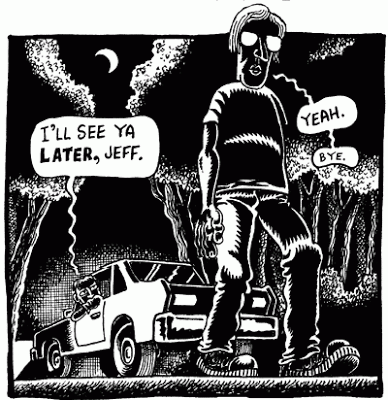
- [THE BIG QUESTION] WHAT’S YOUR FAVORITE FEMALE ENSEMBLE IN MOVIES? - July 22, 2016
- [IN THEATERS NOW] THE BOY (2016) - January 24, 2016
- Cult Movie Mania Releases Lucio Fulci Limited Edition VHS Sets - January 5, 2016
Tags: Derf, Graphic Novels, Jeffrey Dahmer


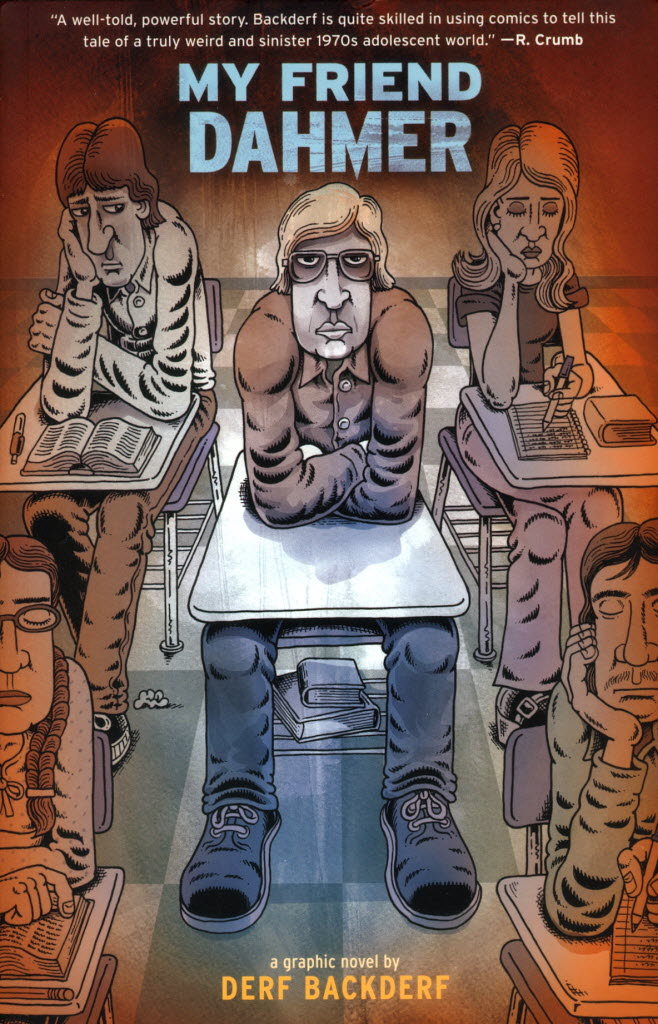




No Comments